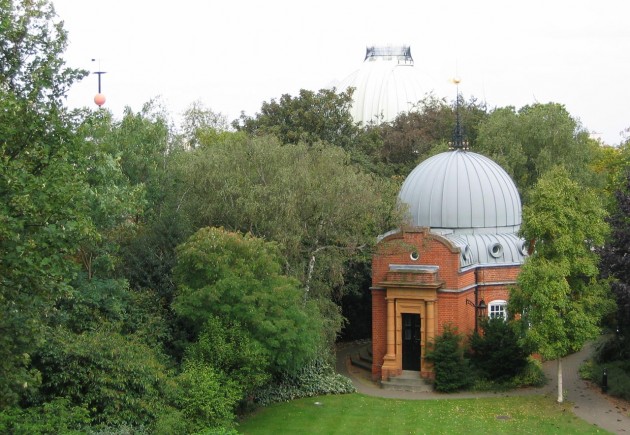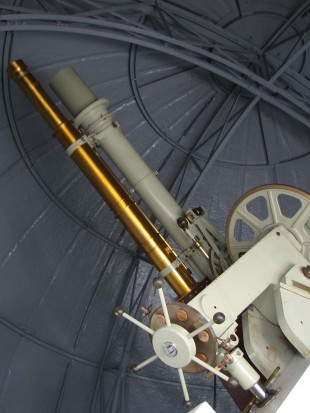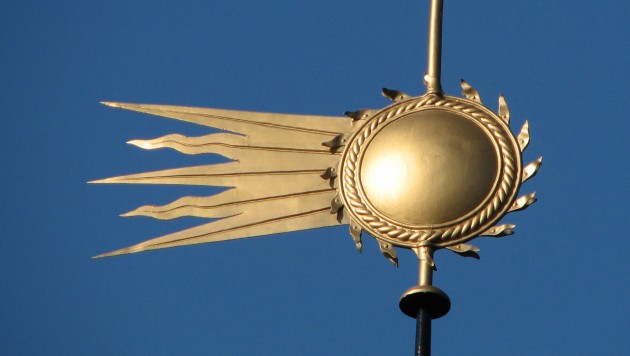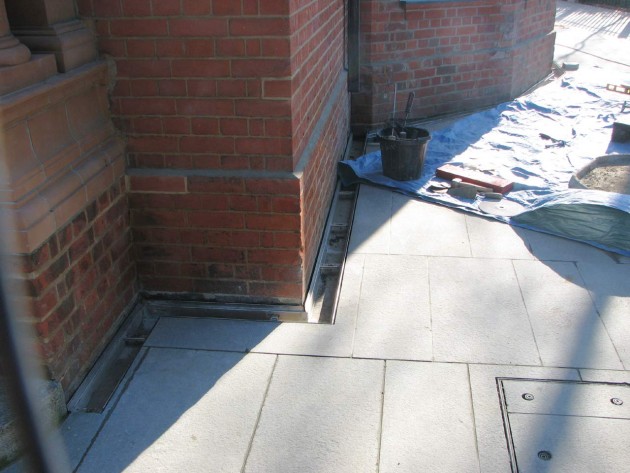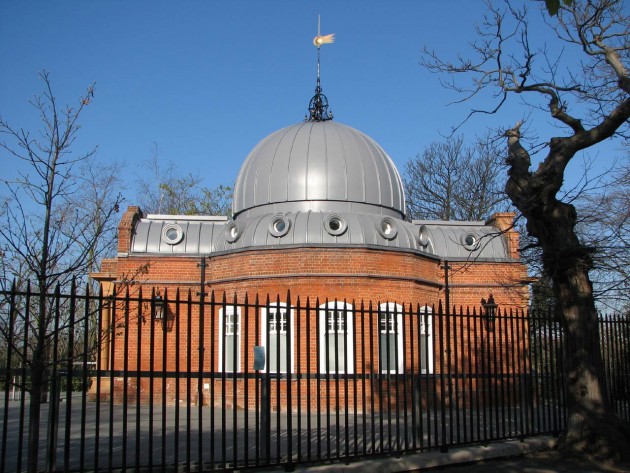…where east meets west
- Home
- Brief History
- The Greenwich Meridian
- Greenwich
(1675–1958) - Herstmonceux
(1948–1990) - Cambridge
(1990–1998) - Outstations (1822–1971)…
- – Chingford (1822–1924)
- – Deal
(1864–1927) - – Abinger
(1923–1957) - – Bristol & Bradford on Avon
(1939–1948) - – Bath
(1939–1949) - – Hartland
(1955–1967) - – Cape of Good Hope
(1959–1971)
- Administration…
- – Funding
- – Governance
- – Inventories
- – Pay
- – Regulations
- – Royal Warrants
- Contemporary Accounts
- People
- Publications
- Science
- Technology
- Telescopes
- Chronometers
- Clocks & Time
- Board of Longitude
- Libraries & Archives
- Visit
- Search
The Altazimuth Pavilion
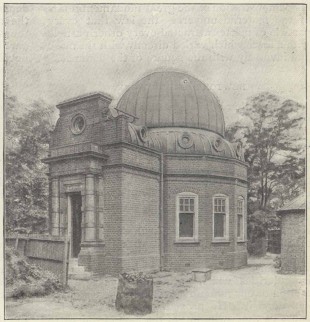
The Altazimuth Pavilion from the south-east soon after its construction (before the weather vane was added). From The Leisure Hour (1898)
The Pavilion was built to house the new Altazimuth Instrument proposed by Christie in 1892. Of solid construction, and of two floors, it was erected in the only space that Christie had available, which was on the South Ground just to the north of the Magnetic House. To avoid excessive interference with the magnetic observations, the site selected was on the magnetic meridian of the declination magnet and 90 feet to the north of it. The centre of the building is 141 feet east and 166 feet south of the Airy Transit Circle.
Like the South Building, it is constructed of red brick and terracotta with a ring of porthole like windows to light the observing floor inside. Christie sometimes referred to the telescope as a universal transit circle, and to this end, as well as the main telescope, there were collimating telescopes at the north and south ends of the building which could be swung into position from beneath the movable roofs that covered them.
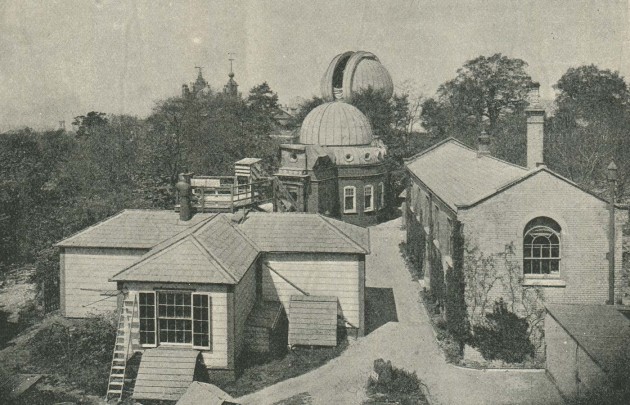
The newly completed Altazimuth Pavilion (centre) in its original setting (as seen from the New Physical Building). Some of the other buildings that can be seen are the Great Equatorial Building (behind), the Magnetic Pavilion (front centre) and the 'New Library' (right). Photo by the London Stereoscopic Company. From Pearson's Magazine (1896)
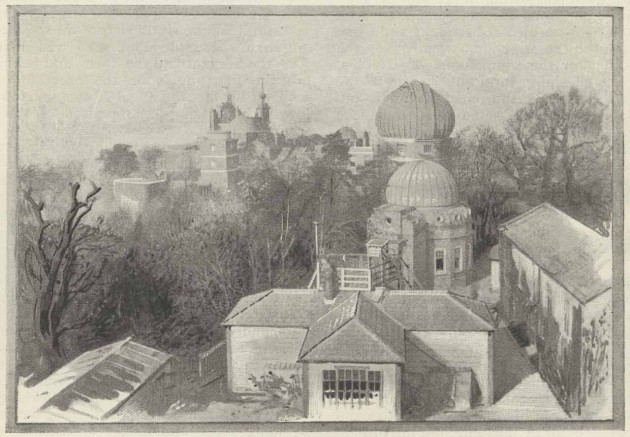
In this slightly later view from a higher viewpoint, more of the background buildings are visible. From The Leisure Hour (1898)
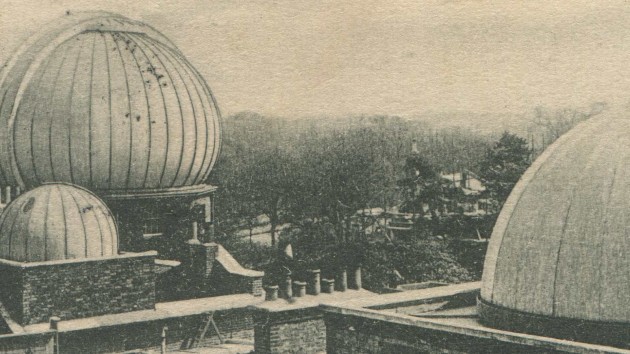
Looking back the other way in 1895 while the Pavilion was under construction. It can just be seen to the left of the right hand dome surrounded by scaffolding. Photo by York & Son. Detail from a postcard published anonymously
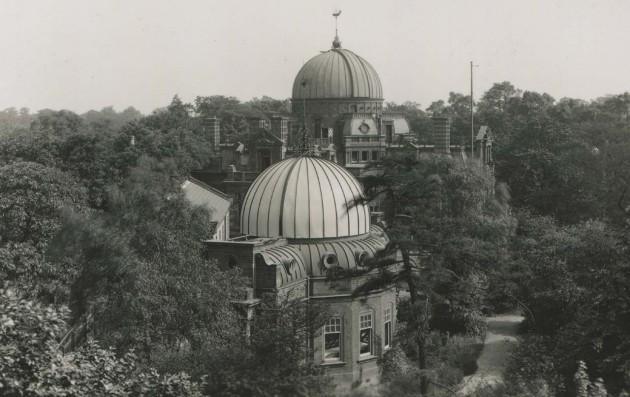
The Pavilion from a similar direction (but slightly further to the left) in about 1930. The New Physical Building is in the background. From a postcard published by the Royal Observatory, Greenwich
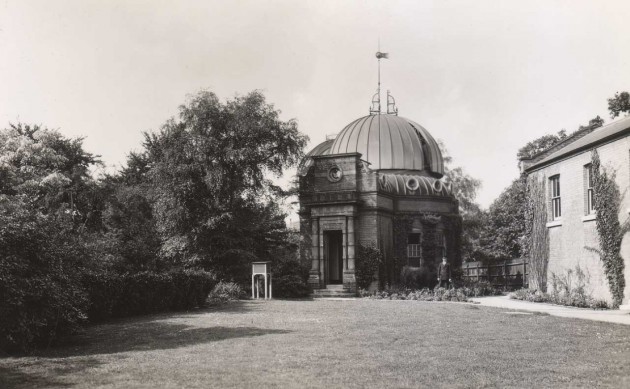
The Altazimuth Pavilion in about 1930. The building to the right is the 'New Library' erected in 1881. From a postcard published by the Royal Observatory, Greenwich
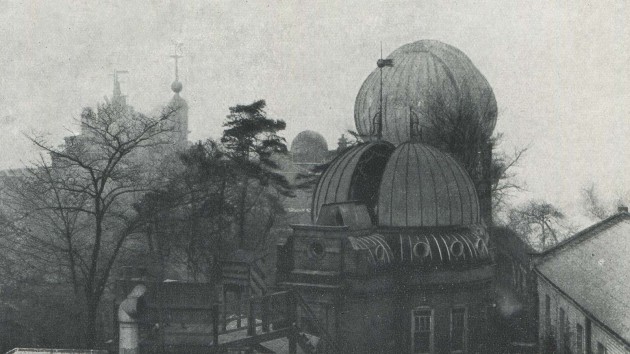
In this view, one of the raised collimators of the Altazimuth Telescope is visible in front of the opening of the dome. From Hutchinson’s Splendour of the Heavens (1923)
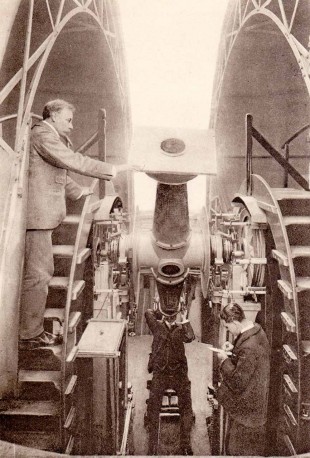
Chrisite's Altazimuth Telescope. Frontispiece to Volume 1 of Harmsworth's Universal Encyclopedia (London 1920/21)
The terracotta decoration was limited by Crisp to the porticos surrounding the two entrances. The dome was built by Sir Howard Grubb and opened in a quite different way to any of the others at Greenwich. It had no shutters. Instead, the two halves of the dome could be slid outwards to create a 4½ foot wide opening. The weather vane represents Halley’s Comet and was added in June 1901.
The Altazimuth Instrument, which was mounted 20 feet above the ground, was never a success. It was dismantled by Spencer Jones at the start of WW2 and replaced with a new instrument to the observatory – a small transit instrument by Cooke Troughton and Simms that had been made for time determinations in Singapore, but never used for that purpose. A brick pier was built on top of the existing one and a raised wooden floor installed above the existing floor to make the telescope accessible for the observers.
War damage
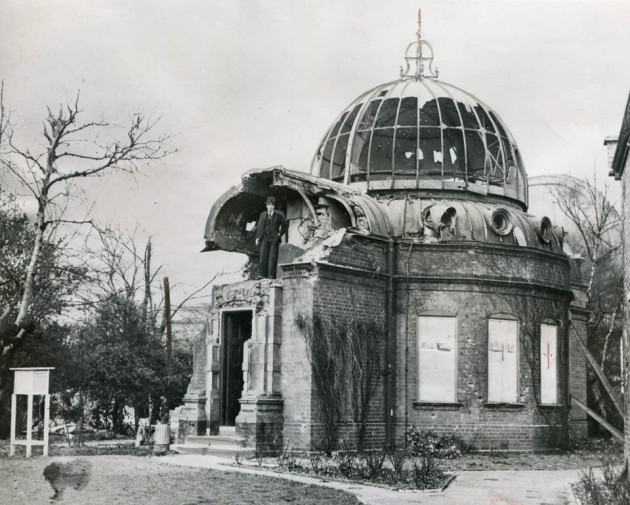
The bomb damaged Altazimuth Pavilion in December 1940. The damaged brickwork and terracotta have been removed, but the south portico is still open to the elements. The photo was published, along with those of other bomb damaged buildings in Bristol, Windsor and elsewhere in the 14 December edition of The Illustrated London News
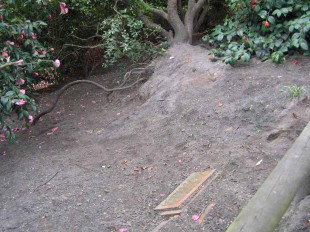
Taken in April 2006, the photo shows some of the pieces of damaged terracotta which were dumped on the slopes to the west of the building
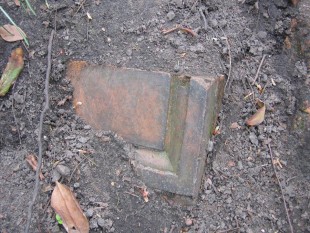
The pieces remained visible on the slopes of the gardens until 2009, when they appear to have been removed when the paths were re-landscaped
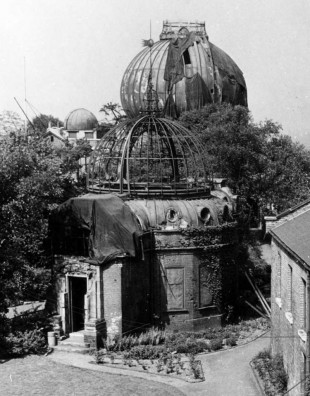
The Altazimuth and Great Equatorial Buildings at the end of the Second World War. Although the photographer is not recorded, it is likely to have been Cecil Beaton who, at the request of the Ministry of Information, made a photographic survey of the Observatory in the reporting year 1944/5. Detail from Ministry of Information photograph D.24700
A home at Greenwich for the telescopes of the Greenwich Time Service
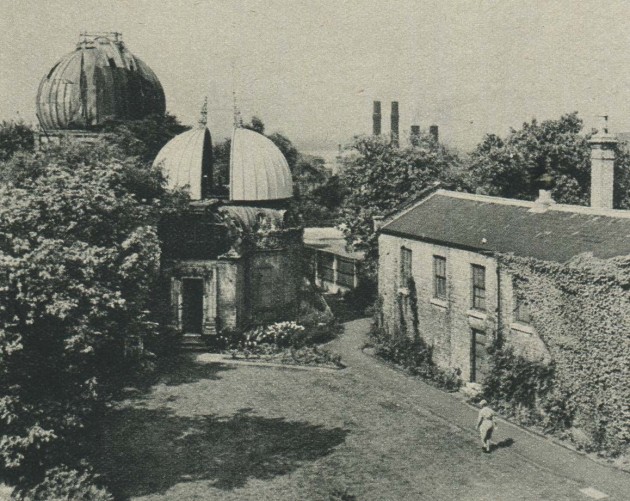
The Altazimuth Pavilion in 1946 after its dome was recovered so that it could house one of the Small Reversible Transit telescopes. The war-time damage above the entrance to the building was not repaired until 1947, a year after this picture was taken. From p.143 of the 28 October 1946 edition of Life
History post 1957
After the announcement had been made in 1946 that the Observatory would be moving to Herstmonceux, the Ministry of Works, to whom the site was to revert on behalf or the Crown, drew up plans to return the southern half of the Observatory site to the Park. Under this plan, only two buildings were to escape demolition, the South Building Store which was destined to become a public lavatory and the Altazimuth Pavilion which was scheduled to be adapted as a shelter by the opening up of the windows on both the east and the west side. Its future looked in doubt when during a ministerial visit that took place on 22 April 1958; Hugh Molson (the Government Minister with oversight for the project) indicated that he wanted it demolished.
In the end, the building was retained and passed into the care of the National Maritime Museum where it was adapted for use both as a shelter and as a new home for the Sheepshanks Equatorial. To this end, the staircase was retained and only the western half adapted as a shelter. Although the terracotta around the southern doorframe was renewed, the rest of the terracotta on the southern end was not. A new concrete pier was constructed on top of the base of the brick pier that had been built for the small transit instrument. The dome was re-clad in fibreglass somewhere around 1965.
The Sheepshanks Equatorial was used by local groups who were given access to the Observatory at night. It remained in place from 1963 until 1982, when it was replaced by the 4-inch Dallmeyer photoheliograph and the Newbegin 6¼-inch refractor following their discontinued use at Herstmonceux. Nick Sidle has two fabulous wide-angle images of the telescope and interior of the dome taken in 1986 which he has put on flickr. They can be viewed by clicking here and here. The photoheliograph was used with schools and the public until around 2004. It was dismounted and placed in storage on 6 October 2017 in order to make way for two modern telescopes.
The dome was and still is (2020) opened and turned by hand. There does not appear to have been any physical mechanism to prevent the wind from blowing it shut, or causing it to rotate. Whilst undoubtedly irritating, this would not have damaged the original Altazimuth Instrument, but the photoheliograph and the Newbegin refractor were too large for the dome and vulnerable to being knocked by the internal structure, not only if the wind caught the dome, but also when they were being manipulated into position. This was particularly problematic with the photoheliograph, which, because it was on a German Equatorial mounting, needed to be flipped over at around midday in order to observe on the opposite side of the meridian. Also problematic was the safety of the public as a result of the raised floor. There were three potential hazards, all of which were managed effectively over the years. Firstly, the steel beam supporting the dome had to be ducked under in order to gain access to the raised floor. Secondly, there were no safety railings at its edge, though in practice, the rail of the dome, which was around waist height, performed this role. Thirdly, there was the danger that members of the public might get their hands or hair caught during the turning of the dome.
Alterations made during the construction of the Peter Harrison Planetarium (2004–07)
During the construction of the Peter Harrison Planetarium, the ground floor of the Altazimuth Pavilion was remodelled and the windows on the west side reinstated. To improve health and safety, a new less steep staircase was installed together with a new raised floor of considerably smaller diameter. Although the latter removed the possibility of individuals getting their hands caught by the dome as it was turned, it created several new problems that hadn’t been properly considered when the changes were planned. Firstly, it became much more difficult to access the lens caps safely and manipulate the telescope and the dome. Secondly, the reduced floor area available at the eye-end of the telescope made if difficult or imposible to observe. These factors together with changing priorities in the Museum, brought the regular use of the photoheliograph to an end.
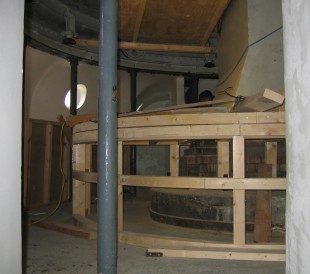
The new raised floor under construction. The one it replaced was considerably larger and extended out as far as the cast iron pillars. Towards the top of the picture one of the wheels on which the dome turns can be seen. The two smaller horizontally mounted wheels are there to ensure that the dome does not slide off the track. Photo: June 2006
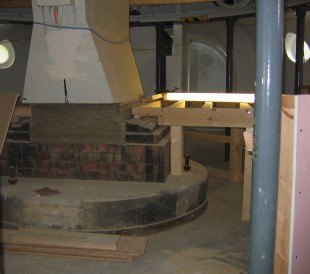
The circular concrete structure is the top of the original Altazimuth pier (complete with bolts). The brickwork on top is what remains of the pier built for the small transit instrument(s). The concrete pier was installed in the 1960s for the Sheepshanks Equatorial. It was later used for the Photoheliograph and Newbegin Refractor. Since 2018, it has supported the 'Annie Maunder Astrographic Telescope'. Photo: June 2006
Alterations were also made to the level, direction of slope and the surface finish of the ground surrounding the building. This resulted in water flowing off the newly paved surface directly into the brickwork at the southern end of the building (and above where a damp course might be expected to be). In order to try and cure the problem, a drainage gulley was later installed adjacent to the building.
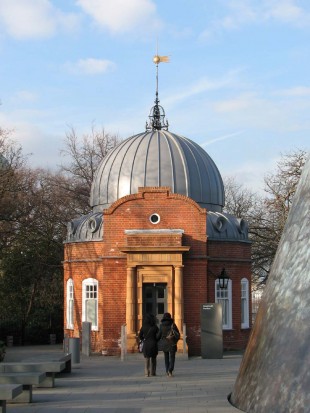
The south portico of the Altazimuth Pavilion in 2009. The building on the right is the Peter Harrison Planetarium which was opened by the Queen in May 2007
Further Reading
Plans of the Altazimuth Pavilion as it existed in 1960 together with those for its proposed conversion into a shelter can be viewed at the National Archives (WORK16/1824)
© 2014 – 2025 Graham Dolan
Except where indicated, all text and images are the copyright of Graham Dolan
